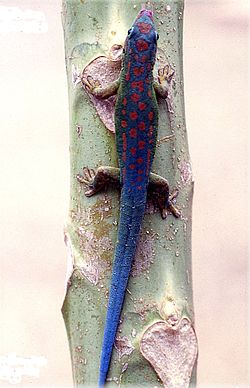파랑꼬리낮도마뱀붙이
package.lua 80번째 줄에서 Lua 오류: module 'Module:Namespace detect/data' not found.
|
| ||||||||||||||||||
 | ||||||||||||||||||
| 생물 분류 | ||||||||||||||||||
|---|---|---|---|---|---|---|---|---|---|---|---|---|---|---|---|---|---|---|
| ||||||||||||||||||
| 학명 | ||||||||||||||||||
| Phelsuma cepediana 밀베르(:en:Milbert), 1812[1] | ||||||||||||||||||
 파랑꼬리낮도마뱀붙이의 분포 | ||||||||||||||||||
| 이명 | ||||||||||||||||||
| *Gecko cepedianus Milbert, 1812 | ||||||||||||||||||
블루테일 데이 게코(blue-tailed day gecko)라 불리는 파랑꼬리낮도마뱀붙이(Phelsuma cepediana) is a diurnal species of gecko, a lizard in the family Gekkonidae. The species is endemic to the island Mauritius. It typically inhabits warm and humid places and dwells on different trees and bushes.
Etymology[편집]
The specific name, cepediana, is in honor of French naturalist Bernard Germain de Lacépède.[2]
Description[편집]

P. cepediana belongs to the middle-sized day geckos. It can reach a total length (including tail) of about 스크립트 오류: "convert" 모듈이 없습니다.. There always is a dorso-lateral stripe present, which may be broken. A red stripe extends from the nostril to the shoulder. The male body colour is light green or bluish green. The backs of males have a bright blue colour and are covered with dark red spots and dashes. The males have deep blue tails. Females lack the brilliant blue colour of the males. They have a bright green back and rust-coloured spots.
Distribution[편집]
The blue-tailed day gecko inhabits the island Mauritius where it is widely distributed. P. cepediana may also have been introduced to Madagascar where it has been reported a few times, amongst others in the region of Iviloina. These observations have not been confirmed though.
Habitat[편집]
P. cepediana is mainly found on bushes and trees such as coconut palms, traveler's palms, banana trees and papayas. It also inhabits gardens and houses in suburban areas. It prefer a moist and warm climate. McKeown (1993) mentions that the original vegetation of Mauritius has been largely replaced with agricultural crops in which this day gecko cannot live.
Diet[편집]
The blue-tailed day gecko feeds on various insects and other invertebrates. It also licks soft, sweet fruit, pollen, and nectar. The flowers of the now critically endangered liana Roussea simplex produce copious amounts of nectar and are pollinated only by the blue-tailed day gecko. The blue-tailed day gecko later on plays a role by licking up a gelatinous substance secreted by the fruit which contains the minute seeds. It disperses the seeds in its droppings. Regrettably, the 2 mm long ant Technomyrmex albipes that was introduced to Mauritius from the Indo-Pacific area seals the flowers of Roussea with clay to protect mealy bugs. These drink the sap and excrete a sugary urine that is collected by the ants. The ants attack animals that visit the plant, preventing the blue-tailed day gecko from pollinating the flowers and eating from the fruit, and in this way seriously hampering Roussea's reproduction.[3]
Behavior[편집]
This Phelsuma species can be quite aggressive both toward its own and to other Phelsuma species. In captivity, where the females cannot escape, the males can also sometimes seriously wound a female. In this case the male and female must be separated.
Reproduction[편집]
The females of P. cepediana lay eggs in a protected location, and glue the eggs. At a temperature of 스크립트 오류: "convert" 모듈이 없습니다., the young will hatch after approximately 40–45 days. The juveniles measure 스크립트 오류: "convert" 모듈이 없습니다..
Care and maintenance in captivity[편집]
P. cepediana should be housed in pairs and needs a large, well planted terrarium. It is important to provide the terrarium with sufficient air flow. The temperature should be between 28 and 스크립트 오류: "convert" 모듈이 없습니다.. The humidity should be maintained between 75 and 100 per cent. In captivity, the blue-tailed day gecko can be fed with crickets, wax moths, fruits flies, mealworms, and houseflies.
References[편집]
- ↑ 1.0 1.1 "Phelsuma cepediana ". The Reptile Database. www.reptile-database.org.
- ↑ Beolens, Bo, Michael Watkins and Michael Grayson (2011). The Eponym Dictionary of Reptiles. Baltimore: Johns Hopkins University Press. xiii + 296 pp. 모듈:Citation/CS1/styles.css 문서에 내용이 없습니다.스크립트 오류: "Catalog lookup link" 모듈이 없습니다.스크립트 오류: "check isxn" 모듈이 없습니다.. (Phelsuma cepediana, p. 149).
- ↑ 스크립트 오류: "citation/CS1" 모듈이 없습니다.
Further reading[편집]
- 스크립트 오류: "citation/CS1" 모듈이 없습니다.
- Henkel, F.-W., and W. Schmidt (1995). Amphibien und Reptilien Madagaskars, der Maskarenen, Seychellen und Komoren. Ulmer Stuttgart. 모듈:Citation/CS1/styles.css 문서에 내용이 없습니다.스크립트 오류: "Catalog lookup link" 모듈이 없습니다.스크립트 오류: "check isxn" 모듈이 없습니다.
- McKeown, Sean (1993). The general care and maintenance of day geckos. Advanced Vivarium Systems, Lakeside CA.
package.lua 80번째 줄에서 Lua 오류: module 'Module:Taxonbar/conf' not found.
This article "파랑꼬리낮도마뱀붙이" is from Wikipedia. The list of its authors can be seen in its historical and/or the page Edithistory:파랑꼬리낮도마뱀붙이. Articles copied from Draft Namespace on Wikipedia could be seen on the Draft Namespace of Wikipedia and not main one.

|
This page exists already on Wikipedia. |
